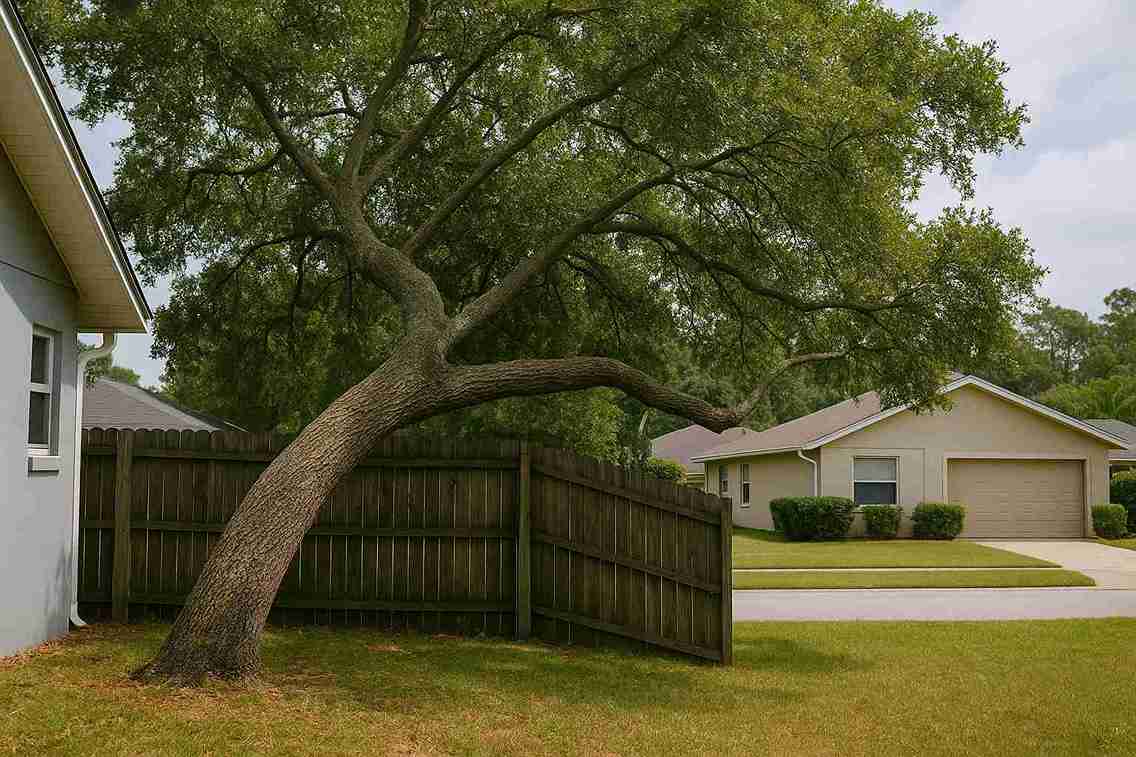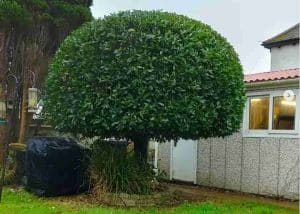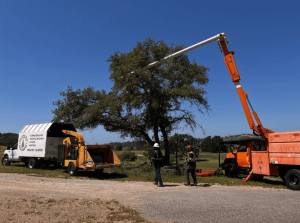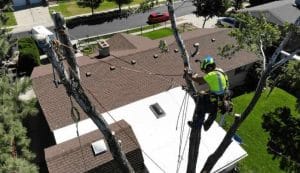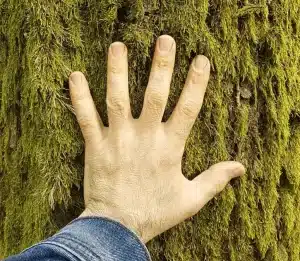If you’re wondering how to fix a tree that is leaning toward your property, you’re not alone. Leaning trees can be unsettling they might look unstable, drop debris, or block sunlight. Even worse, they could fall during storms or high winds. Whether the tree is yours or your neighbor’s, it’s important to know what steps to take. This guide walks you through how to assess the risk, understand your options, communicate with others if needed, and take action to keep your home and yard safe all without causing conflict.
Table of Contents
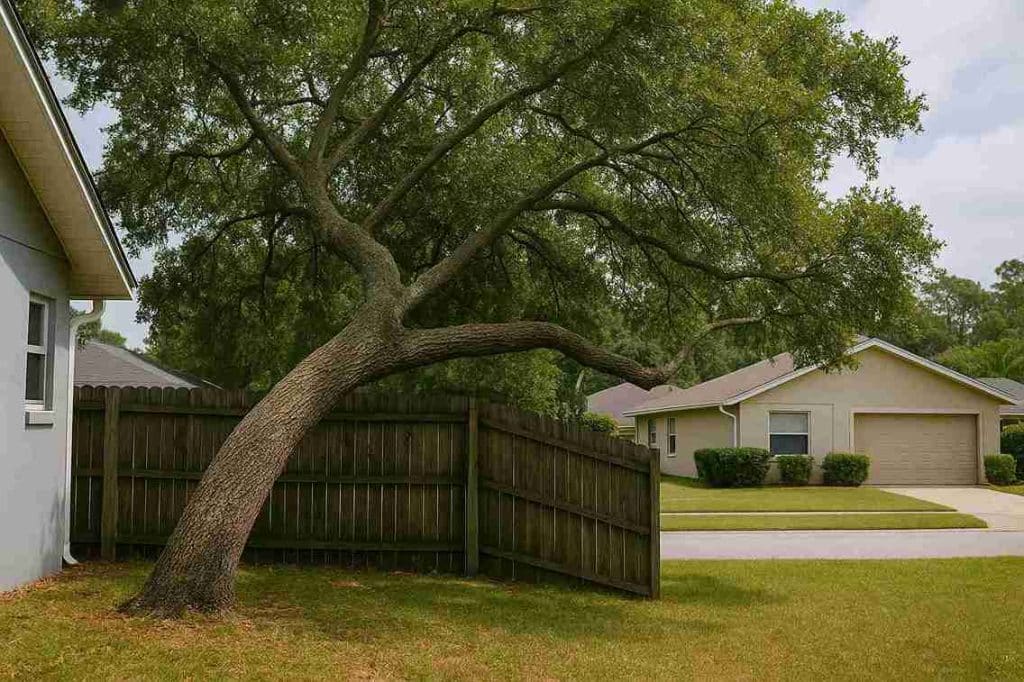
Why a Leaning Tree Causes Concern
A tree leaning over your property from a neighbor’s yard can be more than a small bother. In Ormond Beach, where hurricanes and strong winds are part of life, an unstable tree can pose a real danger. Falling branches or a toppled tree could harm your home, fence, or driveway, leading to costly repairs or even injuries. Even without storms, constant debris like leaves, twigs, or fruit can pile up, making yard maintenance a hassle. For homeowners, these issues can feel frustrating and urgent.
Start by identifying why the tree bothers you. Is it the risk of storm damage? The endless cleanup of leaves? Or the way it affects your property’s look or value? Pinpointing your main concern helps you approach the situation with clarity. For example, a tree shedding leaves is less urgent than one with cracked branches that might fall. Understanding the problem’s scope guides you toward the right solution without overreacting or ignoring a potential hazard.

Step 1: Inspect the Tree Closely
Before taking any steps, examine the tree to understand its condition. Are just a few branches crossing your property line, or is the entire tree leaning dangerously? Here’s how to evaluate it:
- Look for Warning Signs: Check for cracks in the trunk, dead branches, or roots lifting from the ground. These suggest the tree could be unstable.
- Document the Issue: Take clear photos or videos of the tree, particularly if it’s leaning heavily or has caused minor damage, like a cracked fence. These records can help if you need to involve professionals or local authorities later.
- Think About Timing: Ormond Beach’s hurricane season, from June to November, raises the risk of a leaning tree falling. If a storm is approaching, acting quickly becomes critical.
By assessing the tree’s state, you’ll know whether it’s a minor annoyance or a serious threat. This step also prepares you to explain your concerns clearly when talking to your neighbor.
Step 2: Know Your Rights in Ormond Beach
Understanding the legal rules in Ormond Beach helps you act confidently and avoid mistakes. Florida’s property laws apply, but local regulations may add specific requirements. Here’s what you need to know:
- Property Line Rules: In Florida, you can trim branches that extend over your property, as long as you don’t harm the tree’s health. However, you cannot enter your neighbor’s yard to cut the tree without their permission.
- Hazardous Trees: If the tree is clearly dangerous—dead, dying, or leaning precariously—your neighbor is typically responsible for addressing it. If they ignore the issue and the tree causes damage, they could be held liable.
- Local Regulations: Protects certain trees, like live oaks or sabal palms, under local ordinances. Before trimming or removing any tree, check with the City of Ormond Beach’s Planning Department or visit their website to see if permits are required.
To get accurate details, contact the City of Ormond Beach at (386) 677-0311 or check their official website for tree-related rules. Knowing these laws ensures you act within your rights and strengthens your position when discussing the issue with your neighbor.
Step 3: Talk to Your Neighbor Respectfully
Approaching your neighbor about their leaning tree can feel tricky, but a kind conversation often resolves the issue faster than formal steps. Here’s how to handle it:
- Be Polite and Friendly: Assume your neighbor may not realize the problem. Start with a gentle opener like, “I’ve noticed your tree is leaning over my yard, and I’m a bit worried about safety during storms. Can we talk about it?”
- Focus on Solutions: Instead of blaming, suggest working together. For example, offer to share the cost of a professional inspection if the tree seems risky.
- Share Evidence: Show photos or videos of the tree to explain your concerns clearly, keeping the tone cooperative rather than confrontational.
If your neighbor is unresponsive or defensive, don’t push—document your efforts and move to the next steps.
Step 4: Get a Professional Opinion
If the tree looks dangerous or your neighbor isn’t cooperative, a certified arborist can provide expert insight. An arborist will assess the tree’s health and stability, giving you a clear understanding of the risks. Here’s why this step is valuable:
- Expert Analysis: An arborist can confirm whether the tree is likely to fall or if it’s healthy but simply leaning.
- Cost Estimates: They can provide quotes for trimming or removal, which you can share with your neighbor to encourage action.
- Written Report: A professional assessment adds credibility if you need to involve insurance companies or local authorities later.
Hiring an arborist typically costs $100–$300, but it’s a worthwhile investment for clarity and evidence. Look for certified professionals through local directories or community recommendations.
Step 5: Consider Legal and Insurance Steps
If your neighbor refuses to act on a clearly hazardous tree, you may need to take formal steps. Here’s how to proceed carefully:
- Send a Formal Letter: Write a polite letter outlining your concerns, including photos and any arborist report. Use certified mail to create a record of your attempt to resolve the issue.
- Check Your Insurance: Review your homeowner’s insurance policy to understand coverage for damage caused by a neighbor’s tree. In Florida, if your neighbor knew about the hazard but did nothing, they may be liable, though your insurance might cover initial repairs.
- Reach Out to City Officials: If the tree poses a public safety risk, contact Code Enforcement team. They can inspect the tree and may require your neighbor to take action.
Legal action, like a lawsuit, is a last resort—it’s costly and can strain neighbor relations. Focus on collaboration and documentation to resolve the issue without going to court.
Step 6: Act Within Your Rights
If the tree’s branches are over your property and not a major hazard, you can trim them yourself, staying on your side of the property line and avoiding damage to the tree. Here’s how to do it safely:
- Hire a Professional: Unless it’s a small branch, use a licensed tree service in Ormond Beach to ensure safety and proper technique. This prevents injury or accidental harm to the tree.
- Follow Local Rules: Check with the City of Ormond Beach to see if a permit is needed, especially for protected trees like oaks or palms.
- Notify Your Neighbor: Let them know you plan to trim branches over your property to avoid surprises, even though you don’t need their permission.
If the tree requires removal and your neighbor agrees, they’re typically responsible for the cost. If they don’t agree, you may need to negotiate or involve authorities for hazardous trees.
Step 7: Prevent Future Issues
Once the issue is resolved, take steps to avoid similar problems down the road:
- Plant Smartly: When adding trees to your property, choose species that won’t grow too large or lean over property lines. Native trees like sabal palms are durable and storm-resistant.
- Maintain Your Trees: Regularly trim your own trees to prevent them from causing issues for neighbors, setting a good example.
- Build Neighborly Ties: A friendly relationship with your neighbor makes future discussions easier.
Why Acting Quickly Saves Stress
Waiting to address a leaning tree can lead to bigger problems—storm damage, expensive repairs, or disputes with your neighbor. In Ormond Beach, where tropical storms can worsen a tree’s instability, taking action early saves time, money, and worry. Whether it’s trimming branches or arranging for removal, addressing the issue protects your property and keeps your yard safe and enjoyable.

Final Thoughts
A leaning tree near your property doesn’t have to turn into a major problem. By checking the tree’s condition, understanding your legal rights, and approaching any neighbors with calm communication, you can often resolve the issue peacefully. If the tree poses a safety risk or the situation becomes complicated, don’t hesitate to contact a certified arborist or local authorities. The key is to take action before damage occurs. Start by assessing the tree today, and take steps to protect your property and maintain a safe, respectful environment.
FAQs
Can I trim my neighbor’s tree in Ormond Beach FL?
Yes, you can trim branches hanging over your yard, but only up to the property line and without damaging the tree. You don’t need permission to trim your side.
What if my neighbor’s tree leans over my yard?
First, take photos and talk with your neighbor. If it looks dangerous, hire an arborist or contact Ormond Beach Code Enforcement for help and safety advice.
Who pays if my neighbor’s tree damages my home?
If the tree was healthy, your insurance may cover it. But if it was unsafe and your neighbor knew, they may be responsible for repairs or damage costs.
Can I remove a shared tree on the property line?
No, you can’t remove a tree that’s right on the property line without your neighbor’s okay. It legally belongs to both of you, so you must both agree first.
How do I get a tree removal permit in Ormond Beach?
Call the Neighborhood Improvement office or visit City Hall. You’ll need to give details and get approval before removing trees over a certain size or type.
Can I report a neighbor’s tree if it looks unsafe?
Yes, you can report it to Ormond Beach Code Enforcement. They’ll inspect it, and if it’s a danger, they may require your neighbor to fix or remove the tree.
What if my neighbor won’t do anything about the tree?
If talking doesn’t help, send a letter and get a tree expert’s report. You can also involve the city or your insurer if the tree is clearly a safety hazard.
Can I cut tree roots from neighbor’s tree in Florida?
You may trim roots on your side if they harm your yard, but you can’t kill or weaken the tree. Be careful—damaging the tree could make you legally liable.
